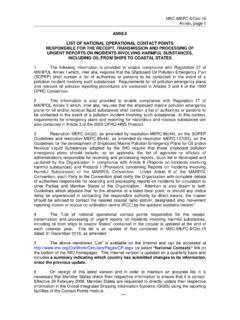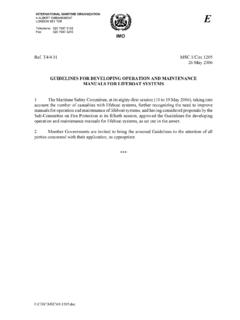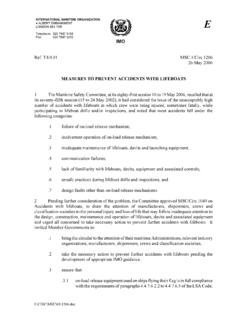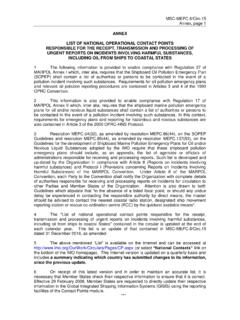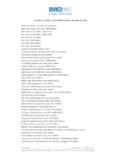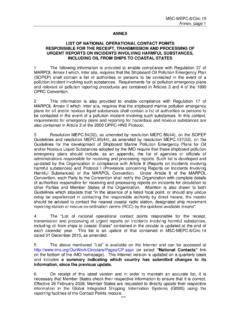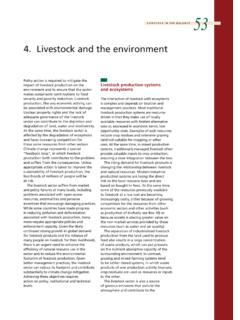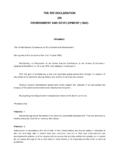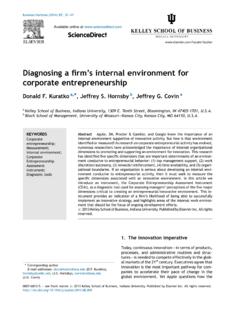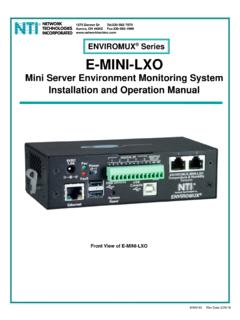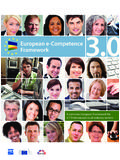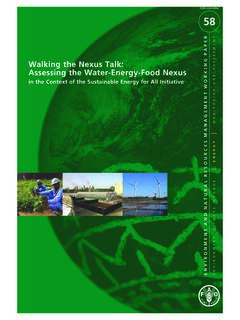Transcription of INTERNATIONAL MARITIME ORGANIZATION E
1 I:\ASSEMBLY\24\RES\ For reasons of economy, this document is printed in a limited number. Delegates are kindly asked to bring their copies to meetings and not to request additional copies. INTERNATIONAL MARITIME ORGANIZATION IMO E ASSEMBLY 24th session Agenda item 11 A 24 6 February 2006 Original: ENGLISH Resolution (24) Adopted on 1 December 2005 (Agenda item 11) REVISED GUIDELINES FOR THE IDENTIFICATION AND DESIGNATION OF PARTICULARLY SENSITIVE SEA AREAS THE ASSEMBLY, RECALLING Article 15(j) of the Convention on the INTERNATIONAL MARITIME ORGANIZATION concerning the functions of the Assembly in relation to regulations and guidelines concerning MARITIME safety, the prevention and control of marine pollution from ships and other matters concerning the effect of shipping on the marine environment, RECALLING ALSO resolution (17) by which the Assembly adopted the Guidelines for the Designation of Special Areas and the Identification of Particularly Sensitive Sea Areas and requested the Marine Environment Protection Committee and the MARITIME Safety Committee to keep the Guidelines under review, RECALLING FURTHER resolution (21)
2 , by which the Assembly adopted Procedures for the Identification of Particularly Sensitive Sea Areas and the Adoption of Associated Protective Measures and Amendments to the Guidelines Contained in Resolution (17) and also requested the Marine Environment Protection Committee and the MARITIME Safety Committee to keep those Procedures and Guidelines under review, NOTING resolution (22), by which it adopted: (a) new Guidelines for the Designation of Special Areas under MARPOL 73/78 , as set out in annex 1 to that resolution, which superseded chapter 2 of the annex to resolution (17) and (b) new Guidelines for the Identification and Designation of Particularly Sensitive Sea Areas , as set out in annex 2 to that resolution, which superseded chapter 3 of the annex to resolutions (17) and (21); and by which it also revoked resolutions (17) and (21) and requested the Marine Environment Protection Committee and the MARITIME Safety Committee to keep the new Guidelines under review, REAFFIRMING that these Guidelines are to be implemented in accordance with INTERNATIONAL law, A 24 - 2 - I:\ASSEMBLY\24\RES\ RECOGNIZING the need to clarify and, where appropriate, strengthen certain aspects and procedures for the identification and subsequent designation of Particularly Sensitive Sea Areas and the adoption of associated protective measures through amendments to the Guidelines for the Identification and Designation of Particularly Sensitive Sea Areas, HAVING CONSIDERED the recommendations made by the Marine Environment Protection Committee at its fifty-third session: 1.
3 ADOPTS the revised Guidelines for the Identification and Designation of Particularly Sensitive Sea Areas as set out in the annex, which supersede those in annex 2 of resolution (22); 2. REQUESTS both the Marine Environment Protection Committee and the MARITIME Safety Committee to keep the revised Guidelines under review; 3. REVOKES annex 2 of resolution (22). - 3 - A 24 I:\ASSEMBLY\24\RES\ ANNEX REVISED GUIDELINES FOR THE IDENTIFICATION AND DESIGNATION OF PARTICULARLY SENSITIVE SEA AREAS 1 INTRODUCTION The Marine Environment Protection Committee (MEPC) of the INTERNATIONAL MARITIME ORGANIZATION (IMO) began its study of the question of Particularly Sensitive Sea Areas (PSSAs) in response to a resolution of the INTERNATIONAL Conference on Tanker Safety and Pollution Prevention of 1978. The discussions of this concept from 1986 to 1991 culminated in the adoption of Guidelines for the Designation of Special Areas and the Identification of Particularly Sensitive Sea Areas by Assembly resolution (17) in 1991.
4 In a continuing effort to provide a clearer understanding of the concepts set forth in the Guidelines, the Assembly adopted resolutions (21) and (22). This document is intended to clarify and, where appropriate, strengthen certain aspects and procedures for the identification and designation of PSSAs and the adoption of associated protective measures. It sets forth revised Guidelines for the Identification and Designation of Particularly Sensitive Sea Areas (the Guidelines or PSSA Guidelines). A PSSA is an area that needs special protection through action by IMO because of its significance for recognized ecological, socio-economic, or scientific attributes where such attributes may be vulnerable to damage by INTERNATIONAL shipping activities. At the time of designation of a PSSA, an associated protective measure1, which meets the requirements of the appropriate legal instrument establishing such measure, must have been approved or adopted by IMO to prevent, reduce, or eliminate the threat or identified vulnerability.
5 Information on each of the PSSAs that has been designated by IMO is available at Many INTERNATIONAL and regional instruments encourage the protection of areas important for the conservation of biological diversity as well as other areas with high ecological, cultural, historical/archaeological, socio-economic or scientific significance. These instruments further call upon their Parties to protect such vulnerable areas from damage or degradation, including from shipping activities. The purpose of these Guidelines is to: .1 provide guidance to IMO Member Governments in the formulation and submission of applications for designation of PSSAs; .2 ensure that in the process all interests those of the coastal State, flag State, and the environmental and shipping communities are thoroughly considered on the basis of relevant scientific, technical, economic, and environmental information regarding the area at risk of damage from INTERNATIONAL shipping activities and the associated protective measures to prevent, reduce, or eliminate that risk; and.
6 3 provide for the assessment of such applications by IMO. 1 The term associated protective measure or measure is used both in the singular and plural throughout these Guidelines. It is important to recognize that an identified vulnerability may be addressed by only one or by more than one associated protective measure and that therefore the use of this terminology in the singular or plural should not be taken as any indication to the contrary. A 24 - 4 - I:\ASSEMBLY\24\RES\ Identification and designation of any PSSA and the adoption of associated protective measures require consideration of three integral components: the particular attributes of the proposed area, the vulnerability of such an area to damage by INTERNATIONAL shipping activities, and the availability of associated protective measures within the competence of IMO to prevent, reduce, or eliminate risks from these shipping activities.
7 2 INTERNATIONAL SHIPPING ACTIVITIES AND THE MARINE ENVIRONMENT Shipping activity can constitute an environmental hazard to the marine environment in general and consequently even more so to environmentally and/or ecologically sensitive areas. Environmental hazards associated with shipping include: .1 operational discharges; .2 accidental or intentional pollution; and .3 physical damage to marine habitats or organisms. Adverse effects and damage may occur to the marine environment and the living resources of the sea as a result of shipping activities. With the increase in global trade, shipping activities are also increasing, thus including greater potential for adverse effects and damage. In the course of routine operations, accidents, and wilful acts of pollution, ships may release a wide variety of substances either directly into the marine environment or indirectly through the atmosphere.
8 Such releases include oil and oily mixtures, noxious liquid substances, sewage, garbage, noxious solid substances, anti-fouling systems, harmful aquatic organisms and pathogens, and even noise. In addition, ships may cause harm to marine organisms and their habitats through physical impact. These impacts may include the smothering of habitats, contamination by anti-fouling systems or other substances through groundings, and ship strikes of marine mammals. 3 PROCESS FOR THE DESIGNATION OF PARTICULARLY SENSITIVE SEA AREAS The IMO is the only INTERNATIONAL body responsible for designating areas as Particularly Sensitive Sea Areas and adopting associated protective measures. An application to IMO for designation of a PSSA and the adoption of associated protective measures, or an amendment thereto, may be submitted only by a Member Government.
9 Where two or more Governments have a common interest in a particular area, they should formulate a co-ordinated proposal2. The proposal should contain integrated measures and procedures for co-operation between the jurisdictions of the proposing Member Governments. Member Governments wishing to have IMO designate a PSSA should submit an application to MEPC based on the criteria outlined in section 4, provide information pertaining to the vulnerability of this area to damage from INTERNATIONAL shipping activities as called for in section 5, and include the proposed associated protective measures as outlined in section 6 to prevent, reduce or eliminate the identified vulnerability. Applications should be submitted in accordance with the procedures set forth in section 7 and the rules adopted by IMO for submission of documents. 2 It is clear that the Guidelines recognize that an application for designation of a PSSA may be submitted by one or more Governments.
10 For ease of drafting, however, the use of the word Government will be used throughout the text and it should be recognized that this term applies equally to applications where there is more than one Government involved. - 5 - A 24 I:\ASSEMBLY\24\RES\ If, in preparing its submission for a PSSA proposal, a Member Government requires technical assistance, that Government is encouraged to request such assistance from IMO. 4 ECOLOGICAL, SOCIO-ECONOMIC, OR SCIENTIFIC CRITERIA FOR THE IDENTIFICATION OF A PARTICULARLY SENSITIVE SEA AREA The following criteria apply to the identification of PSSAs only with respect to the adoption of measures to protect such areas against damage, or the identified threat of damage, from INTERNATIONAL shipping activities. These criteria do not, therefore, apply to the identification of such areas for the purpose of establishing whether they should be protected from dumping activities, since that is implicitly covered by the London Convention 1972 (the Convention on the Prevention of Marine Pollution by Dumping of Wastes and Other Matter, 1972) and the 1996 Protocol to that Convention.
